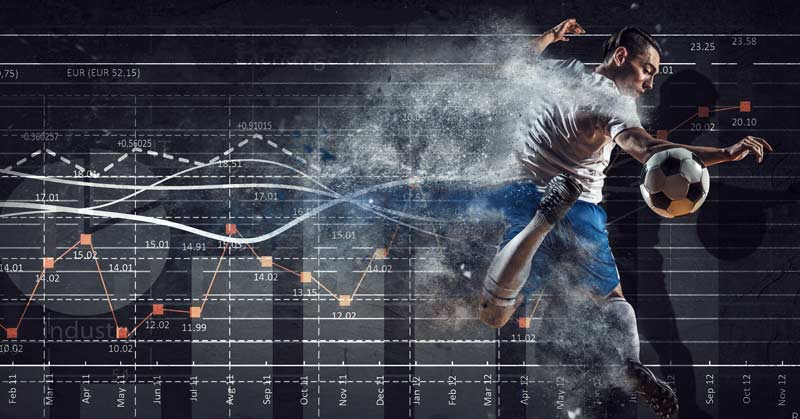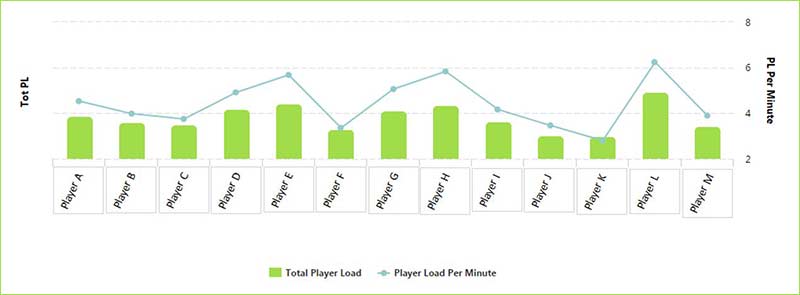
Player monitoring has become commonplace among professional and collegiate sports teams. While you can use many different types of systems to monitor an athlete’s movements on the field, this piece describes my experience with Catapult, widely considered the gold standard for athlete monitoring.
Specifications of the Catapult S5 System
Catapult’s OptimEye S5 system is their most widely used and researched system. Its ability to pick up the micromovements that other systems cannot sets it apart from those other player-monitoring systems. GPS is limited, as it can only record distances and velocities, and is unable to pick up changes in direction.
Catapult has a proprietary formula that uses the information from the accelerometers, gyroscopes, and magnetometer within the device to measure the orientation of the athlete. The system converts the data into a number it calls “IMA” (Inertial Movement Analysis). IMA data gives the user information such as magnitude and direction of any accelerations and decelerations, changes of direction, and jumps. Catapult collects these values at 100Hz, which assures that virtually every movement is quantified.

The primary parameters that Catapult devices measure are Player Load and Player Load per Minute. Player Load is an athlete’s mechanical work in the three axes, where high accelerations are more valuable than low accelerations. This is a volume measure that shows how much work an athlete does over a given period of time. Player Load per Minute is the rate of accumulation of Player Load, and I treat it as a measure of intensity.
Objective Data That Aids in Periodization
The two primary goals of sports science are to mitigate injury risk and increase performance. As coaches, we understand the benefits of periodizing volumes and intensities in the weight room to elicit the best adaptation possible, while keeping the risk of injury low. I love the quote, “You cannot manage what you cannot measure,” because it is so true in sport.
Although the management of loads and intensities in weight training sessions is extremely important, it is a much more controlled environment than the field of play, and comprises a much smaller component of the overall stress an athlete will endure. More importantly, the field is where we look to increase performance and, at the same time, where most injuries occur. Catapult enables a coach to get objective data on practice and game sessions. This helps them periodize loads on a weekly, monthly, and yearly basis to put their team in the best position for success on game day.
Injury Mitigation and Fatigue Reduction
There has been a lot of talk about Tim Gabbett’s acute/chronic training load theories in the past couple of years. He often states that it is not the high training loads that cause problems—it is how we arrive at those training loads. High training volumes are essential because they allow the athlete to be more durable in times of high physical stress, such as games. It is vital to build up that volume over time to arrive at those high training loads safely.

The Catapult system tracks this through an extremely useful training wizard that automatically displays data in an acute to chronic graph. An athlete performing at a high level in a fatigued state is a cause for concern. By understanding when an athlete is fatigued, we can now monitor their time spent in the parameters that indicate high levels of stress, such as: high IMA movements, high velocities, and time spent in a high heart rate zone.
Understanding the parameters measured by Catapult allows you to protect your athletes from injury. Share on XYou can also protect your athletes by understanding the difference between parameters and using your knowledge of anatomy and biomechanics. For instance, if an athlete complains of knee pain, you can go back and look at the number of accelerations and decelerations the athlete has recently been exposed to and possibly reduce future exposure to those qualities so that the athlete can recover. The same goes for hamstring issues, and limiting high-velocity running. With IMA measuring three-dimensional vectors, a coach can now see if an athlete has asymmetrical force output. This is valuable for both injury prevention and return-to-play protocols.

Once you have developed a sizable database, you can dive into higher level means of injury mitigation, such as working to identify high training loads and injury thresholds for an individual athlete. This is an advanced use of the system that requires continued monitoring of the athletes, as well as statistical analysis.
Injuries are an unfortunate reality in all sports. An organization that wants to maximize their likelihood for success will look for ways to identify risk factors for injury. Catapult’s ability to measure the mechanical stress an athlete is exposed to allows sport scientists to dive into the data to identify if an injury occurred because of a certain stimulus.
Athlete Readiness on Game Day
A steep decline in an athlete’s performance can be a major risk factor for an athlete. We must understand that weight training, practice, games, and life are all different stressors, but they all have a cumulative effect on an athlete’s performance. It is advantageous for the coaching staff to have objective data to confirm the level of stress and gain subjective data to understand types of stress. This allows them to create an intervention plan moving forward.
No matter the type of stress, too much of it will lead to fatigue and a decrease in performance. This can be measured as a decrease in mechanical output through the Catapult system. I like to cross-reference the mechanical data from Catapult with other objective measures, such as heart rate variability, and subjective measures such as RPE, wellness questionnaires, and athlete conversations. This creates the clearest picture when looking at the state of readiness for a given athlete. The ability to understand the level and type of fatigue gives the coach insight as to when to push the athletes harder, or when to allow time for recovery.
Increase Performance in Practice and Competition
Increasing performance is the goal of all coaches. I chose to put this last because, if we can manage fatigue and mitigate injuries, the athlete can participate and train at their highest ability. If you plan the training session correctly, it will lead to an increase in performance.
Being present at practices allows you to “tag” different drills. Identifying which drills target different parameters is a great way to show a coach what is happening throughout practice, which they might not have known otherwise. I think that creating a “menu” for the coaching staff on the cost of each drill is a great way to educate them on the capabilities of the system.
Another great way to relay a suggestion to a coach is to relate the session or drill to game speed. If you can utilize this technology during games, you can quantify what “game speed” actually is during a practice or training session.
My Suggestion to Keeping Athlete Tracking Practical
My advice to anyone new to Catapult is to keep it simple. Catapult measures 1,000 data points a second, so it is easy to try to look at too many things at once, and try to draw conclusions from the beginning. This is a mistake, because the message to the coach will be unclear. You don’t have to have all the answers from the data; if you have no information to give them it is okay.
Using this system is a process. I do not believe in relying entirely on this system for all the answers. I think it is important to use our coaching intuition to drive our programs, and Catapult is a tool that can help confirm whether we should tweak the model. I think Catapult is the most user-friendly player-monitoring tool on the market. It can customize almost anything you want, and make your dashboards specific to your needs and your team’s needs.
The number of teams and clubs that use this system around the world also tells me that this product is effective. I strongly suggest reaching out to other users to discover new ways to use the system and different ways to help your team. Catapult is a system where the more work you put into it, the more actionable decisions you will be able to make.
Since you’re here…
…we have a small favor to ask. More people are reading SimpliFaster than ever, and each week we bring you compelling content from coaches, sport scientists, and physiotherapists who are devoted to building better athletes. Please take a moment to share the articles on social media, engage the authors with questions and comments below, and link to articles when appropriate if you have a blog or participate on forums of related topics. — SF


Great article